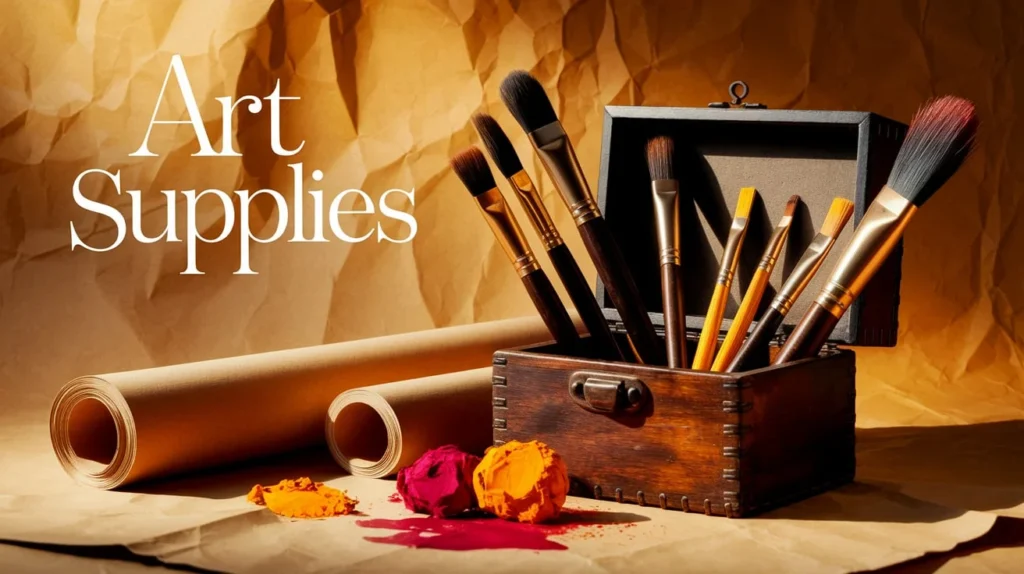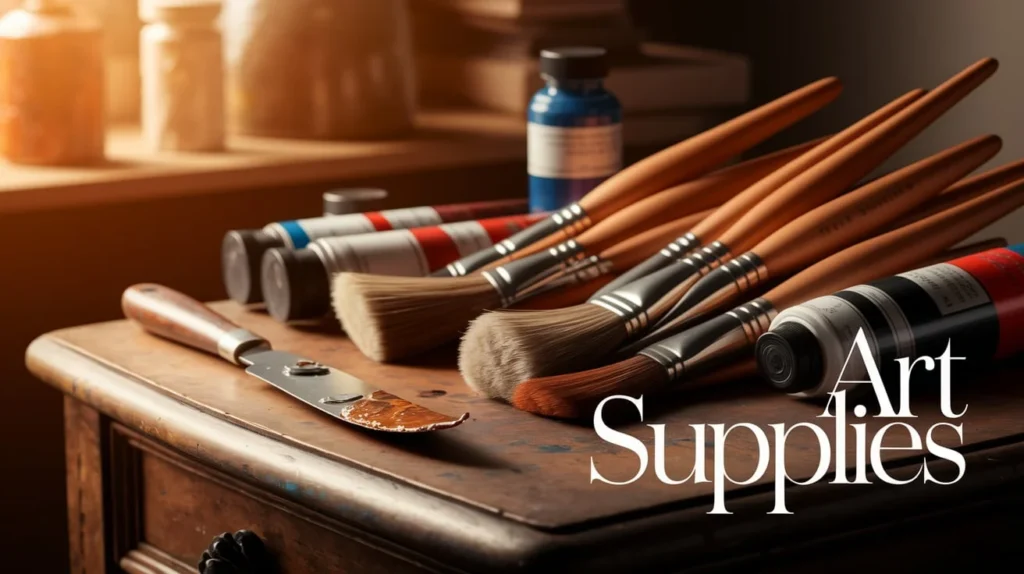Art has always been the universal language of human expression, and at the center of it all lies one simple truth: without art supplies, creativity would remain only in imagination. From a child’s first box of crayons to a professional artist’s oil paints, the materials chosen shape not only how the artwork looks but also how it feels to create it.
The phrase art supplies refers to the broad collection of tools, mediums, and resources that bring ideas to life. These include painting brushes, sketching kits, watercolors, acrylics, pencils, pastels, sculpting clay, and even digital drawing tablets. For centuries, artists have relied on these creative tools to reflect cultural traditions, challenge social norms, and tell stories that words alone could not express.
This detailed guide explores the fascinating world of art supplies from their historical roots and cultural importance to their modern evolution and future trends. Whether you are a beginner searching for the best drawing essentials, a teacher building a classroom art kit, or a professional looking for sustainable creative tools, this article will provide everything you need to understand and choose the right art supplies for your creative journey.
Definition and Importance of Art Supplies
At its core, art supplies can be defined as materials, instruments, and surfaces that artists use to produce visual works. These range from simple graphite pencils to complex airbrush systems and professional-grade tablets.
Their importance cannot be overstated:
- Artistic Quality: The type of paintbrush or paper directly affects the texture, finish, and durability of the artwork.
- Learning and Experimentation: Beginners need accessible tools to practice techniques without overwhelming costs.
- Professional Mastery: Advanced artists require precision materials that allow control, richness of colour, and archival longevity.
- Personal Expression: The choice of supplies is also symbolic; minimalist sketchbooks suggest simplicity, while vibrant acrylic palettes express bold energy.
In short, art supplies are not passive tools. They actively shape the artistic process, influence the final product, and help artists communicate their unique voice.
Historical and Cultural Significance of Art Supplies
Early Civilizations
The first known art supplies were drawn directly from nature. Prehistoric humans painted with charcoal, ochre, and animal fats on cave walls like those in Lascaux, France. These primitive tools gave humanity its earliest stories and spiritual symbols.
Ancient Egypt and Mesopotamia
Egyptians used reed brushes, ground mineral pigments, and papyrus scrolls. Mesopotamians developed carving tools for clay tablets, shaping the origins of written communication and artistic expression.
Chinese and Japanese Traditions
The East contributed significantly to the development of art supplies. Chinese calligraphy brushes, made from bamboo and animal hair, became not only tools but philosophical objects reflecting harmony and discipline. Japanese artists refined sumi ink and paper, essential for both calligraphy and painting.
The Renaissance
During the Renaissance, advancements in oil paint revolutionized art. Artists like Leonardo da Vinci and Michelangelo crafted works using hand-ground pigments, wooden palettes, and sculpting chisels. This period emphasized precision, perspective, and realism made possible by improved tools.
Modern Times
The Industrial Revolution introduced mass production of art materials, making paints, papers, and brushes affordable to a wider population. In the 20th century, spray paints transformed street art, while digital tablets in the 21st century reshaped illustration and design.
Throughout history, art supplies have not only followed but also shaped cultural movements. Every civilization developed unique tools that mirrored its philosophy, traditions, and values.
Categories of Art Supplies

1. Painting Supplies
Painting is one of the oldest and most diverse art forms. Key supplies include:
- Paints: Oils, acrylics, gouache, and watercolours each offer unique textures. Oils are slow-drying and rich; acrylics are fast and versatile; watercolors are light and transparent.
- Brushes: Bristle, sable, synthetic, and fan brushes allow for a range of strokes.
- Surfaces: Canvas, wood panels, watercolor paper, and mixed-media pads.
- Accessories: Palettes, easels, and varnishes to preserve work.
2. Drawing Supplies
Drawing tools are essential for both fine art and design.
- Pencils: Graphite in hardness grades (H for hard, B for bold).
- Charcoal: Produces expressive, dramatic shading.
- Inks and Pens: Calligraphy pens, markers, and fineliners.
- Papers: Sketchbooks, bristol boards, toned papers.
- Extras: Erasers, blending stumps, rulers, compasses.
3. Sculpting Supplies
Three-dimensional art requires its own toolkit.
- Clay: Air-dry, polymer, ceramic, or oil-based clays.
- Tools: Wire cutters, carving knives, loop tools, armatures for support.
- Casting Materials: Plaster, resin, and molds for replication.
4. Printmaking Supplies
Artists practicing printmaking use:
- Carving blocks (linoleum, wood)
- Cutting tools (gouges, knives)
- Ink rollers (brayers)
- Printing presses or hand-burnishing tools
5. Digital Art Supplies
The modern era has expanded the definition of art supplies.
- Tablets: Wacom, Huion, and iPads with styluses.
- Software: Photoshop, Illustrator, Corel Painter, Procreate.
- Accessories: Digital brushes, calibration tools, and color monitors.
6. Mixed-Media and Experimental Supplies
Artists who blend media often need adhesives, collage materials, spray paints, or found objects. This category embraces experimentation and unconventional creativity.
Essential Art Supplies for Beginners
For those just starting, an overwhelming variety of art supplies can be intimidating. A beginner-friendly kit should include:
- A sketchbook with medium-weight paper.
- Graphite pencils (2H, HB, 2B, 6B).
- A kneaded eraser for light lifting and a vinyl eraser for precision.
- Colored pencils or a small watercolor set.
- Synthetic brushes (round, flat, and detail).
- Student-grade acrylics for easy experimentation.
- Canvas boards or mixed-media pads.
- Ruler and blending stumps.
- A compact palette and water container.
- Optional: charcoal sticks for expressive sketches.
Beginners should focus on versatility and affordability while exploring different media. The goal is practice, not perfection.
Professional-Grade Art Supplies for Advanced Artists
Experienced artists often require specialized tools that enhance precision and longevity. Examples include:
- Brushes: High-quality sable brushes for watercolor, hog bristle for oil painting.
- Paints: Artist-grade oils and watercolors with high pigment load.
- Paper: Archival, acid-free paper for longevity.
- Canvas: Hand-stretched, primed canvases.
- Digital: Pressure-sensitive tablets with customizable styluses.
- Sculpting: Premium clays, chisels, and metal tools.
- Fixatives: To protect charcoal or pastel works.
- Varnishes: To preserve oil and acrylic paintings.
These supplies are more expensive but essential for producing professional-level, museum-quality work.
Sustainable and Eco-Friendly Art Supplies
Eco-conscious creativity is on the rise. Examples of sustainable art supplies include:
- Bamboo or recycled-wood paintbrushes
- Recycled sketchbooks and biodegradable paper
- Soy-based or water-based inks
- Non-toxic, plant-based paints
- Clay made from natural, biodegradable materials
- Solar-powered digital tools
Using eco-friendly supplies not only helps the environment but also inspires new generations of artists to create responsibly.
Comparison of Different Brands and Materials
- Winsor & Newton: Trusted for professional paints and papers.
- Faber-Castell: Excellent pencils and pastels for all levels.
- Prismacolor: Richly pigmented colored pencils, loved by illustrators.
- Copic Markers: Professional-grade markers for designers and manga artists.
- Derwent: Known for innovative pencils and sketching materials.
- Sennelier: Luxury pastels and paints with deep pigments.
- Wacom: The gold standard in digital drawing tablets.
- Huion: Affordable alternative for digital beginners.
Each brand offers unique advantages depending on skill level and budget.
Tips for Choosing the Right Art Supplies
- Define your medium before shopping.
- Investing in quality paper or canvas, which elevates even cheap paints.
- Try student-grade materials before upgrading.
- Read reviews and test samples when possible.
- Match tools to style: fine-liners for detail, broad brushes for expressive strokes.
- Don’t overspend. Talent grows with practice, not expensive supplies.
- Consider eco-friendly options.
Real-Life Applications and Examples in Art
- Van Gogh: Used oil paints with heavy textures to convey emotion.
- Picasso: Experimented with charcoal, oils, and found objects for Cubism.
- Banksy: Relies on spray paint and stencils for urban art.
- Digital artists: Blend traditional sketching with digital tablets for hybrid results.
Each artist demonstrates how the choice of supplies becomes part of their style and artistic identity.
Future Trends in Art Supplies
- Smart Brushes: Devices that translate real brush strokes into digital art.
- 3D Printing: Sculptors using digital files to print complex models.
- AR and VR Art: Immersive art created with virtual brushes.
- Eco-Innovation: Plant-based paints, algae inks, recycled canvases.
- Hybrid Kits: Merging traditional paints with digital scanning technology.
The future is about blending tradition with technology while staying sustainable.
Conclusion
Art supplies are the silent partners of every artist’s journey. From the charcoal of prehistoric caves to the styluses of modern tablets, these tools have shaped how humanity expresses its deepest thoughts and emotions.
Beginners need simple, affordable materials to practice and grow. Professionals require high-grade, precise supplies to create enduring works. Eco-friendly tools are helping redefine creativity in a sustainable way, while future innovations promise endless new possibilities.
Ultimately, art supplies are not just objects. They are vessels of imagination, heritage, and innovation. Choosing them wisely means choosing the voice through which your creativity speaks.

